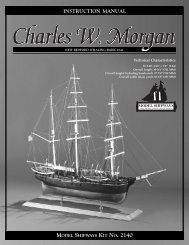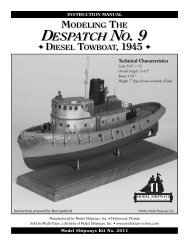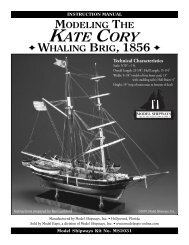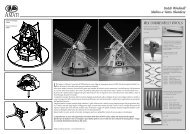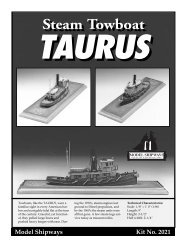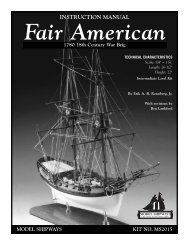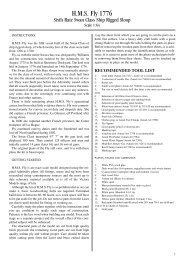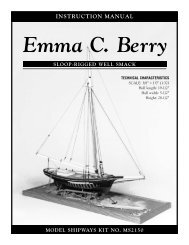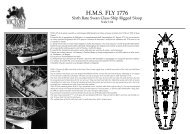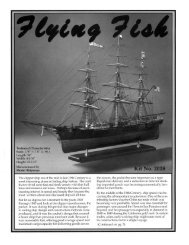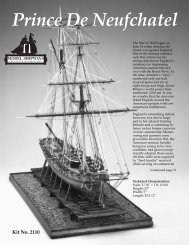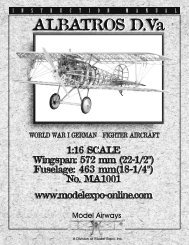download benjamin latham instruction manual
download benjamin latham instruction manual
download benjamin latham instruction manual
Create successful ePaper yourself
Turn your PDF publications into a flip-book with our unique Google optimized e-Paper software.
STAGE H<br />
FIG. 66 – Locating the Chainplates<br />
STANDING RIGGING<br />
As mentioned in the discussion under General Rigging Information,<br />
all lines for the standing rigging should be blackened<br />
in color.<br />
1. Chainplates<br />
These fittings are one of the foundations for the standing rigging<br />
and should be considered carefully for this reason. The<br />
chainplates for this vessel are tricky–probably the toughest job<br />
on the whole model. They can be fitted well only once; any<br />
mistakes will show badly and be almost impossible to correct<br />
without leaving tell-tale marks. Consider yourself forewarned!<br />
Locating the Chainplates: First, find the precise locations of<br />
the chainplates at the rails. The forward port and starboard<br />
chainplates for the fore shrouds lay athwart the center of the<br />
fore mast at the deck. This applies to the forward main shroud<br />
chainplates, too (see figure 66 and the rigging plans). Mark<br />
these positions with a pencil, then measure and mark the positions<br />
of the chainplates which lay abaft their respective leaders.<br />
See the rigging and deck plans for spacing intervals and transfer<br />
these spacings carefully using a pair of dividers.<br />
There are three lower shrouds on both sides of each mast. The<br />
chainplates of each group should be evenly spaced. Equally<br />
spaced between the second and third chainplates of each<br />
triplet lays a fourth and smaller chainplate for the topmast<br />
shrouds. Be sure that all of these positions are marked clearly<br />
and exactly.<br />
Achieving the Proper Angle: Each chainplate should be<br />
mounted at an angle relative to the rake of the mast. First, step<br />
the masts so they stand nearly vertical (see the rigging plan,<br />
and for the moment, disregard the previous sermon on sprung<br />
masts). Take a length of cordage and loop and tie it at a point<br />
on the mast where the shrouds will eventually be placed. Then<br />
extend the line of cordage down to the rail where a chainplate<br />
should be fitted (see figure 67). Pull the cord to the waterline,<br />
holding it taut, and strike a line from the reference mark at the<br />
rail to the lowest limit of the chainplate. Such a line should be<br />
created for each chainplate in order to determine its proper individual<br />
angle.<br />
Making the Chainplates: Included in the kit are sixteen prefabricated<br />
chainplates that will allow for a simplified installation<br />
(see Figure 68). This method requires a minimum of tools and<br />
is recommended for the beginner. Normally, the chainplate is<br />
recessed into the hull planking with its upper end “buried” in<br />
the cap rail, as will be described in the next paragraph. But, if<br />
you adopt the simplified installation, you will be able to forego<br />
these maneuvers.<br />
For those interested in building precisely detailed Essex chainplates,<br />
one method is shown in figure 69. If the kit chainplates<br />
displease you, the eyes may be cut off and smaller holes drilled<br />
along the length of each piece. The widths of these pieces are<br />
actually just right for the four topmast shroud chainplates. The<br />
twelve lower shroud chainplates require that you buy three<br />
#985 brass strips measuring .017” x 1/16” x 6.” You will find<br />
them in the Model Expo catalog.<br />
FIG. 67 – Achieving the Proper Angle<br />
Cordage<br />
Pin<br />
First fore<br />
chainplates<br />
First main<br />
chainplates<br />
FIG. 68 – Simplified Chainplates<br />
Deadeye<br />
Strop ring<br />
Trestle trees<br />
Chainplate<br />
Topmast<br />
Loop & knot<br />
Scriber<br />
Lower limit<br />
of chainplate<br />
FOR LOWER SHROUDS<br />
Scratch mark<br />
Lill pin<br />
35



